
Open6GHub develops a 6G vision for sovereign citizens in a hyper-connected world from 2030. The aim of the Open6GHub is to provide contributions to a global 6G harmonization process and standard in the European context. We consider German interests in terms of our societal needs (sustainability, climate protection, data protection, resilience, …) while maintaining the competitiveness of our companies and our technological sovereignty. Another interest is the position of Germany and Europe in the international competition for 6G.
Open6GHub will contribute to the development of an overall 6G architecture, but also end-to-end solutions in the following, but not limited to, areas: advanced network topologies with highly agile organic networking, security and resilience, THz and photonic transmission methods, sensor functionalities in the network and their intelligent use, as well as processing and application-specific radio protocols.
Funding: BMBF
Project time: 08/2021–07/2025
Website: Project

Wireless networks are about to step into new application areas. Besides broadband internet and energy-efficient sensor networking, they are also considered for mission-critical applications, like remote-controlled vehicles (e.g., UAVs), vehicular networks, and industrial automation systems. These types of applications pose new demands on the availability, the robustness, and the latency of wireless links.
The subproject studies novel concepts and strategies that support these use-cases. One of the major requirements is that both the network and the application are able to cope with the whole spectrum between perfect connectivity and temporary outages. An example could be a UAV that switches automatically between interactive real-time control, if connectivity is good, and semi-autonomous control through waypoints in case of sporadic connectivity.
The developed concepts will be evaluated in realistic scenarios through prototype implementations.
Funding: DFG
Project time: 01/2021–12/2024
Website: Project

The LOEWE center emergenCITY, established in 2020, combines the extensive research in Hesse on resilient and crisis-proof infrastructures in digital cities. emergenCITY is an interdisciplinary and multi-site collaboration led by Technische Universität Darmstadt, Universität Kassel, and Philipps-Universität Marburg. Twenty-three professors from the fields of computer science, electrical engineering and information technology, mechanical engineering, social sciences and history, architecture, economics, and law conduct research in four interlinked program areas: City and Society, Information, Communication, and Cyber-Physical Systems.
Funding: LOEWE
Project time: 01/2020–12/2023
Website: Project

PhySim11p is the project associated with my Marie Curie fellowship, where I work on a more realistic physical layer simulation model for IEEE 802.11p. The project is advised by Prof. Linda Doyle and executed at the Connect Center of Trinity College Dublin. The goal is to use my SDR implementation of IEEE 802.11p to characterize link performance through simulations and experiments, and use the results to derive physical layer simulations models that can be used in macroscopic network simulators.
Funding: H2020 (Marie Curie Fellowship)
Project time: 05/2017–04/2019
Website: Project, Funding Body
![]() Bastian Bloessl and Aisling O’Driscoll, “A Case for Good Defaults: Pitfalls in VANET Physical Layer Simulations,” Proceedings of IFIP Wireless Days Conference 2019, Manchester, UK, April 2019.
[DOI, BibTeX, PDF and Details…]
Bastian Bloessl and Aisling O’Driscoll, “A Case for Good Defaults: Pitfalls in VANET Physical Layer Simulations,” Proceedings of IFIP Wireless Days Conference 2019, Manchester, UK, April 2019.
[DOI, BibTeX, PDF and Details…]
![]() Bastian Bloessl, Florian Klingler, Fabian Missbrenner and Christoph Sommer, “A Systematic Study on the Impact of Noise and OFDM Interference on IEEE 802.11p,” Proceedings of 9th IEEE Vehicular Networking Conference (VNC 2017), Torino, Italy, November 2017, pp. 287-290.
[DOI, BibTeX, PDF and Details…]
Bastian Bloessl, Florian Klingler, Fabian Missbrenner and Christoph Sommer, “A Systematic Study on the Impact of Noise and OFDM Interference on IEEE 802.11p,” Proceedings of 9th IEEE Vehicular Networking Conference (VNC 2017), Torino, Italy, November 2017, pp. 287-290.
[DOI, BibTeX, PDF and Details…]
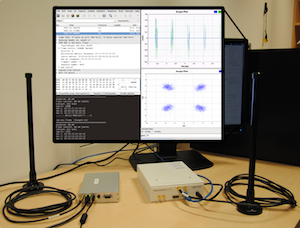
I implemented an IEEE 802.11a/g/p transceiver based on GNU Radio that supports all modulation and coding schemes, runs completely in software, and supports a wide range of SDRs. It’s well suited for both simulative and experimental performance evaluation of WiFi and Vehicular Ad Hoc Networks.
Funding: internal
Project time: 10/2012–now
On other sites:
![]() Bastian Bloessl, Michele Segata, Christoph Sommer and Falko Dressler, “Performance Assessment of IEEE 802.11p with an Open Source SDR-based Prototype,” IEEE Transactions on Mobile Computing, vol. 17 (5), pp. 1162-1175, May 2018.
[DOI, BibTeX, PDF and Details…]
Bastian Bloessl, Michele Segata, Christoph Sommer and Falko Dressler, “Performance Assessment of IEEE 802.11p with an Open Source SDR-based Prototype,” IEEE Transactions on Mobile Computing, vol. 17 (5), pp. 1162-1175, May 2018.
[DOI, BibTeX, PDF and Details…]
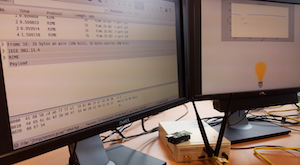
I extended Thomas Schmid’s ZigBee transceiver to a complete network stack for IEEE 802.15.4 devices. It even supports the RIME stack of the Contiki operating system, a well-known operating system for sensor motes.
Funding: internal
Project time: 10/2011–now
On other sites:
Bastian Bloessl, Christoph Leitner, Falko Dressler and Christoph Sommer, “A GNU Radio-based IEEE 802.15.4 Testbed,” Proceedings of 12. GI/ITG KuVS Fachgespräch Drahtlose Sensornetze (FGSN 2013), Cottbus, Germany, September 2013, pp. 37-40. [BibTeX, PDF and Details…]

WiME is an umbrella project for my SDR-based research projects. The idea is to have one spot with information and documentation of the various projects to make them more accessible to others.
Funding: internal
Project time: 10/2011–now
Website: www.wime-project.net
![]() Bastian Bloessl, Mario Gerla and Falko Dressler, “IEEE 802.11p in Fast Fading Scenarios: From Traces to Comparative Studies of Receive Algorithms,” Proceedings of 22nd ACM International Conference on Mobile Computing and Networking (MobiCom 2016), 1st ACM International Workshop on Smart, Autonomous, and Connected Vehicular Systems and Services (CarSys 2016), New York, NY, October 2016.
[DOI, BibTeX, PDF and Details…]
Bastian Bloessl, Mario Gerla and Falko Dressler, “IEEE 802.11p in Fast Fading Scenarios: From Traces to Comparative Studies of Receive Algorithms,” Proceedings of 22nd ACM International Conference on Mobile Computing and Networking (MobiCom 2016), 1st ACM International Workshop on Smart, Autonomous, and Connected Vehicular Systems and Services (CarSys 2016), New York, NY, October 2016.
[DOI, BibTeX, PDF and Details…]

We use SDR to study the performance of IEEE 802.11p in realistic environments to understand whether the technology that was initially designed for relatively static indoor environments can cope with the high dynamics of vehicular networks.
Funding: DAAD (German Academic Exchange Service)
Project time: 09/2015–03/2016
Project Partner: Prof. Mario Gerla, UCLA
Website: Project
![]() Bastian Bloessl, Mario Gerla and Falko Dressler, “IEEE 802.11p in Fast Fading Scenarios: From Traces to Comparative Studies of Receive Algorithms,” Proceedings of 22nd ACM International Conference on Mobile Computing and Networking (MobiCom 2016), 1st ACM International Workshop on Smart, Autonomous, and Connected Vehicular Systems and Services (CarSys 2016), New York, NY, October 2016.
[DOI, BibTeX, PDF and Details…]
Bastian Bloessl, Mario Gerla and Falko Dressler, “IEEE 802.11p in Fast Fading Scenarios: From Traces to Comparative Studies of Receive Algorithms,” Proceedings of 22nd ACM International Conference on Mobile Computing and Networking (MobiCom 2016), 1st ACM International Workshop on Smart, Autonomous, and Connected Vehicular Systems and Services (CarSys 2016), New York, NY, October 2016.
[DOI, BibTeX, PDF and Details…]

This project is focused mainly on understanding, modeling, exploiting and possibly improving the IEEE 802.11 standard amendment 802.11p or WAVE (Wireless Access in Vehicular Environment).
Funding: BIT PhD School
Project time: 04/2012–03/2015
Website: Project
![]() Michele Segata, Bastian Bloessl, Stefan Joerer, Christoph Sommer, Mario Gerla, Renato Lo Cigno and Falko Dressler, “Towards Communication Strategies for Platooning: Simulative and Experimental Evaluation,” IEEE Transactions on Vehicular Technology, vol. 64 (12), pp. 5411-5423, December 2015.
[DOI, BibTeX, PDF and Details…]
Michele Segata, Bastian Bloessl, Stefan Joerer, Christoph Sommer, Mario Gerla, Renato Lo Cigno and Falko Dressler, “Towards Communication Strategies for Platooning: Simulative and Experimental Evaluation,” IEEE Transactions on Vehicular Technology, vol. 64 (12), pp. 5411-5423, December 2015.
[DOI, BibTeX, PDF and Details…]
![]() Michele Segata, Stefan Joerer, Bastian Bloessl, Christoph Sommer, Falko Dressler and Renato Lo Cigno, “PLEXE: A Platooning Extension for Veins,” Proceedings of 6th IEEE Vehicular Networking Conference (VNC 2014), Paderborn, Germany, December 2014, pp. 53-60.
[DOI, BibTeX, PDF and Details…]
Michele Segata, Stefan Joerer, Bastian Bloessl, Christoph Sommer, Falko Dressler and Renato Lo Cigno, “PLEXE: A Platooning Extension for Veins,” Proceedings of 6th IEEE Vehicular Networking Conference (VNC 2014), Paderborn, Germany, December 2014, pp. 53-60.
[DOI, BibTeX, PDF and Details…]

BATS is a multi-disciplinary project funded by the German research foundation. The goal is to equip bats with very light-weight sensor motes to track bats in the wild and study the social behavior in their natural habitat. In our subproject, we designed the data communication and built an SDR-based prototype.
DFG (German Research Foundation)
Project time: 12/2012–12/2018
Website: Project, CCS subproject
![]() Bastian Bloessl and Falko Dressler, “mSync: Physical Layer Frame Synchronization Without Preamble Symbols,” IEEE Transactions on Mobile Computing, vol. 17 (10), pp. 2321-2333, October 2018.
[DOI, BibTeX, PDF and Details…]
Bastian Bloessl and Falko Dressler, “mSync: Physical Layer Frame Synchronization Without Preamble Symbols,” IEEE Transactions on Mobile Computing, vol. 17 (10), pp. 2321-2333, October 2018.
[DOI, BibTeX, PDF and Details…]
![]() Muhammad Nabeel, Bastian Bloessl and Falko Dressler, “Efficient Receive Diversity in Distributed Sensor Networks using Selective Sample Forwarding,” IEEE Transactions on Green Communications and Networking, vol. 2, pp. 336-345, June 2018.
[DOI, BibTeX, PDF and Details…]
Muhammad Nabeel, Bastian Bloessl and Falko Dressler, “Efficient Receive Diversity in Distributed Sensor Networks using Selective Sample Forwarding,” IEEE Transactions on Green Communications and Networking, vol. 2, pp. 336-345, June 2018.
[DOI, BibTeX, PDF and Details…]
![]() Muhammad Nabeel, Bastian Bloessl and Falko Dressler, “Selective Signal Sample Forwarding for Receive Diversity in Energy-Constrained Sensor Networks,” Proceedings of IEEE International Conference on Communications (ICC 2017), Paris, France, May 2017.
[DOI, BibTeX, PDF and Details…]
Muhammad Nabeel, Bastian Bloessl and Falko Dressler, “Selective Signal Sample Forwarding for Receive Diversity in Energy-Constrained Sensor Networks,” Proceedings of IEEE International Conference on Communications (ICC 2017), Paris, France, May 2017.
[DOI, BibTeX, PDF and Details…]
![]() Muhammad Nabeel, Bastian Bloessl and Falko Dressler, “On Using BOC Modulation in Ultra-Low Power Sensor Networks for Wildlife Tracking,” Proceedings of IEEE Wireless Communications and Networking Conference (WCNC 2016), Doha, Qatar, April 2016, pp. 848-853.
[DOI, BibTeX, PDF and Details…]
Muhammad Nabeel, Bastian Bloessl and Falko Dressler, “On Using BOC Modulation in Ultra-Low Power Sensor Networks for Wildlife Tracking,” Proceedings of IEEE Wireless Communications and Networking Conference (WCNC 2016), Doha, Qatar, April 2016, pp. 848-853.
[DOI, BibTeX, PDF and Details…]

EN-ACT aims to drastically reduce energy consumption and CO2 emissions of applications and systems based on Information and Communication Technology (ICT).
EU/INTERREG
Project time: 09/2012–06/2014
Website: Project
![]() Michele Segata, Bastian Bloessl, Christoph Sommer and Falko Dressler, “Towards Energy Efficient Smart Phone Applications: Energy Models for Offloading Tasks into the Cloud,” Proceedings of IEEE International Conference on Communications (ICC 2014), Sydney, Australia, June 2014, pp. 2394-2399.
[DOI, BibTeX, PDF and Details…]
Michele Segata, Bastian Bloessl, Christoph Sommer and Falko Dressler, “Towards Energy Efficient Smart Phone Applications: Energy Models for Offloading Tasks into the Cloud,” Proceedings of IEEE International Conference on Communications (ICC 2014), Sydney, Australia, June 2014, pp. 2394-2399.
[DOI, BibTeX, PDF and Details…]
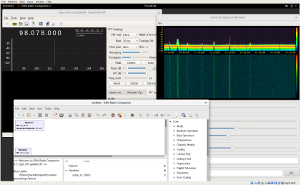
Instant GNU Radio is a programmatically generated VM and live environment for SDR. It can be easily adapted and branded for specific courses. The base image comes with a sane environment that supports a wide range of SDRs and comes with basic applications pre-installed.
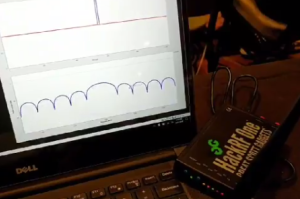
On some channels in the 5GHz band, WLAN is only the secondary user. The primary users are weather radars. Before opening an access point, WLAN cards have to sense the channel to make sure that they do not interfere with radars. In the project, I emulated radar pulses to test this functionality on various WLAN cards.
On other sites:
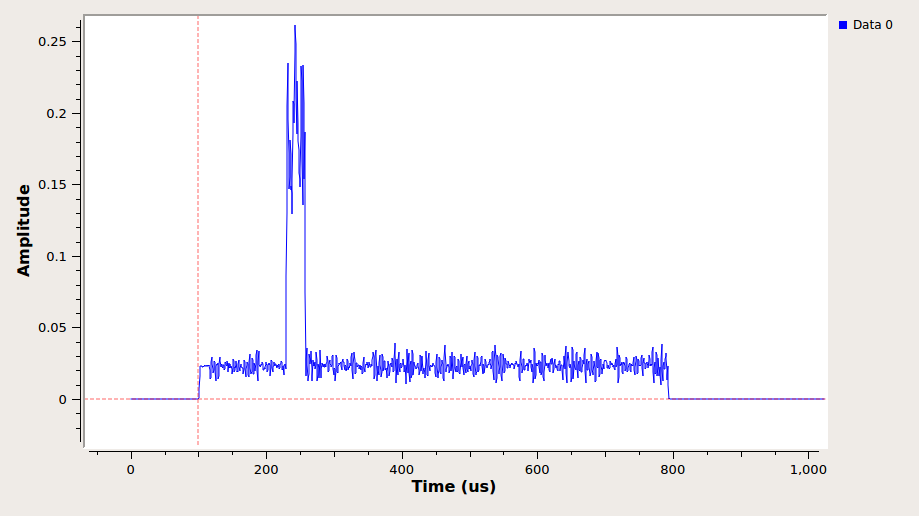
Based on Mathy Vanhoef’s firmware modifcations for some Atheros WiFi cards, we are investigating their potential to operate as reactive jammers. In particular, we are interested in the limitatons in terms of delay, the reliability that a jamming signal is sent, and the effectivenes of the jam signal.
Website: Blog post
On other sites:
The reactive jammer was also used in:
![]() Bastian Bloessl, Florian Klingler, Fabian Missbrenner and Christoph Sommer, “A Systematic Study on the Impact of Noise and OFDM Interference on IEEE 802.11p,” Proceedings of 9th IEEE Vehicular Networking Conference (VNC 2017), Torino, Italy, November 2017, pp. 287-290.
[DOI, BibTeX, PDF and Details…]
Bastian Bloessl, Florian Klingler, Fabian Missbrenner and Christoph Sommer, “A Systematic Study on the Impact of Noise and OFDM Interference on IEEE 802.11p,” Proceedings of 9th IEEE Vehicular Networking Conference (VNC 2017), Torino, Italy, November 2017, pp. 287-290.
[DOI, BibTeX, PDF and Details…]
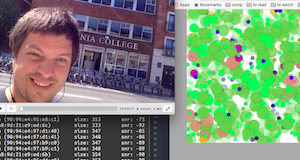
I am interested in alternative approaches to make the spectrum visible and audible. With SpectroPhone, I captured all WiFi signals and painted them as circles on a canvas. The color indicates the manufacturer of the chip that sent the frame, the size indicates the data that it carries, and the fade duration indicates the signal strength. To make it audible, I mapped the manufacturer to notes on the c major scale and let the signals play the notes.
On other sites:

I noticed that both the buses and the signs at the bus stops are equipped with rather long antennas that—as it turns out—are used to disseminate telemetry data that allows to predict the arrival of the bus. I reversed the physical layer and large parts of the data payload and created an interactive map that displays the position and state of the buses.
Website: Blog post
On other sites:

Placing two pairs of mobile traffic lights directly in front of our house provided the perfect opportunity to study their signals. I reversed the physical and link layer and implemented my own receiver that outputs the state of the traffic light in a web interface.
Website: Blog post, Blog post, Blog post
On other sites:

I maintain a GNU Radio RDS implementation. That’s a project I continued and extended quite a bit. RDS is a data subcarrier on ordinary FM broadcasts that allows the radio to display the station name, for example. With TMC, RDS can also be used to disseminate traffic information. As the whole system is unencrypted and unauthenticated it can serve as a demonstrator for spoofing traffic messages.
On other sites:

In 2014, I bought a car and, of course, had to reverse its wireless key fob. It uses a rather simple modulation in the 433MHz band. As it turns out, the security of the key is based on a 64-bit rolling code. I made some progress, but did not (yet?) have the big break through.
On other sites:
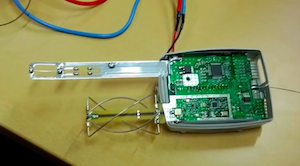
On a hike through the forest, I found a weather sonde from Vaisala launched by the German military. Fortunately, I found a GNU Radio module from a hacker space in Prague that I restructured and extended with live graphs of the sensor data.
Website: GitHub
On other sites:

I redesigned the website of ACM MobiHoc 2016. It uses Bootstrap for the frontend and a Gulp workflow—scaffolded with the gulp-webapp Yeoman generator—for the backend.
Website
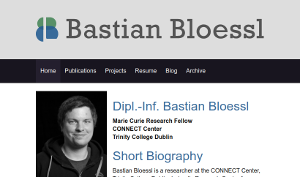
My personal blog where I write about stuff that I find interesting. The blog uses static websites and is built with a custom Gulpfile.
Website

My girlfriend’s photo blog is based on a responsive theme from HTML 5 Up. I extended it pretty heavily and transformed it into an Wordpress theme.
Website
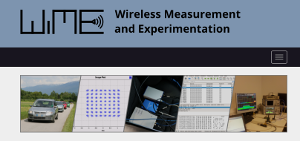
Like my personal blog, the WiME website uses static websites that are built with plain Gulp. It uses a custom design that is based on Bootstrap.
Website